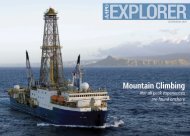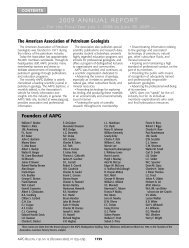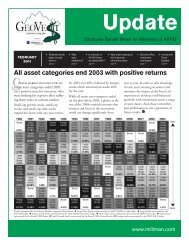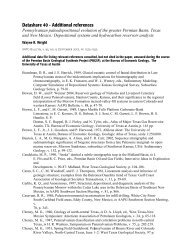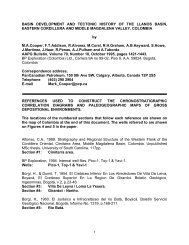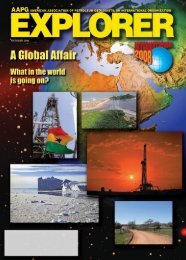AAPG Explorer - American Association of Petroleum Geologists
AAPG Explorer - American Association of Petroleum Geologists
AAPG Explorer - American Association of Petroleum Geologists
You also want an ePaper? Increase the reach of your titles
YUMPU automatically turns print PDFs into web optimized ePapers that Google loves.
Continued from previous page<br />
The turbidites are interpreted as proximal<br />
channel deposits that occur near the base<br />
<strong>of</strong> slope.<br />
Spectacular deformed beds were visible<br />
in outcrops <strong>of</strong> the trench-filling Valdez<br />
Group, including slaty cleavage in shales,<br />
smeared shale beds and intensely fractured<br />
tabular sandstone beds. These deposits,<br />
believed to be Maastrictian to Campanian<br />
in age, were scraped <strong>of</strong>f the seafloor as the<br />
Pacific Plate subducted, and uplifted as if<br />
on a regional conveyer-belt.<br />
Both the McHugh Complex and the<br />
Valdez Group comprise the most impressive<br />
Chugach terrain.<br />
* * *<br />
The stratigraphic record <strong>of</strong> the Cook<br />
Inlet Basin includes a thick Mesozoic<br />
succession overlain by nearly 26,000 feet<br />
<strong>of</strong> Tertiary section. All significant petroleum<br />
production to date has come from Tertiary<br />
age reservoirs in upper Cook Inlet.<br />
The stratigraphy <strong>of</strong> the Sterling Formation<br />
reservoirs are exposed in shoreline bluffs<br />
several hundred feet thick near Clam Gulch<br />
and the town <strong>of</strong> Ninilchik. They contain<br />
tabular sand bodies with conglomeratic lags<br />
deposited in braided channels, lignite beds<br />
and abundant sedimentary features.<br />
Broadly lenticular sand bodies <strong>of</strong> the<br />
Beluga Formation are exposed in the bluff<br />
PNBs<br />
from page 34<br />
Mohit Khanna, to chief development<br />
geologist, Salamander Energy, Jakarta,<br />
Indonesia. Previously Mukta subsurface<br />
manager, BG Group, Mumbai, India.<br />
Thomas S. Liberatore, to partner,<br />
executive vice president and chief<br />
executive <strong>of</strong>ficer, Eclipse Resources, State<br />
College, Pa. Previously vice president and<br />
Appalachian regional manager, Cabot Oil<br />
& Gas, Pittsburgh.<br />
Brian C. Mahood, to vice presidentgeology,<br />
Las Vegas, Nev. Previously<br />
consultant, Kerrisdale Consulting, Calgary,<br />
Canada.<br />
Brian Panetta, to vice presidentgeology,<br />
Eclipse Resources, State College,<br />
Pa. Previously geologist, Waco Oil & Gas,<br />
Glenville, W.Va.<br />
Chris Peltonen, to geoscience manger,<br />
southern California operations, Venoco,<br />
Carpinteria, Calif. Previously development<br />
geologist, Venoco, Carpinteria, Calif.<br />
Ray Podany, to manager <strong>of</strong> geology-<br />
Permian Basin, Yates <strong>Petroleum</strong>, Artesia,<br />
N.M. Previously senior geologist, Yates<br />
<strong>Petroleum</strong>, Artesia, N.M.<br />
Spencer Quam, to head <strong>of</strong> exploration<br />
operations, Qatar <strong>Petroleum</strong>, Doha, Qatar.<br />
Previously asset manager, Sasol <strong>Petroleum</strong>,<br />
Johannesburg, South Africa.<br />
Stephen M. Testa, president <strong>of</strong> the<br />
<strong>AAPG</strong> Energy Minerals Division and<br />
executive <strong>of</strong>ficer <strong>of</strong> the California State<br />
Mining and Geology Board, has written a<br />
book, “One Man’s Planet” and is available<br />
through the <strong>American</strong> Geological Institute.<br />
John R. Wheeler, to vice president, Lee<br />
Keeling and Associates, Tulsa. Previously<br />
senior geologist, Lee Keeling and<br />
Associates, Tulsa.<br />
northwest <strong>of</strong> the town <strong>of</strong> Homer.<br />
The sands in both formations are<br />
largely well-sorted and unconsolidated<br />
with abundant sedimentary structures.<br />
Dewatering features such as disturbed<br />
bedding and flame structures are<br />
particularly abundant, raising the question <strong>of</strong><br />
their origin – they may have been generated<br />
by natural fluvial depositional processes or<br />
perhaps generated by regional seismicity<br />
common to this tectonic setting.<br />
* * *<br />
Overall the Cook Inlet Basin oral session<br />
and field trip left many with a greater<br />
appreciation <strong>of</strong> this tectonically active basin,<br />
its oil and gas potential and the quality <strong>of</strong><br />
future potential reservoirs.<br />
Thanks to the Alaska Geological<br />
Society and Apache Corporation for their<br />
sponsorship <strong>of</strong> these efforts. EXPLORER<br />
<strong>AAPG</strong><br />
EXPLORER<br />
Sands <strong>of</strong> the Sterling Formation along the east shore <strong>of</strong> Cook Inlet, near Clam Gulch, exhibit<br />
sedimentary structures within braided fluvial channels. Extensive dewatering features may be<br />
due to natural stream processes during deposition and/or local seismic events. These sands<br />
are gas productive reservoirs <strong>of</strong>fshore. They are laminated, cross-bedded and friable.<br />
WWW.<strong>AAPG</strong>.ORG JULY 2011<br />
37



